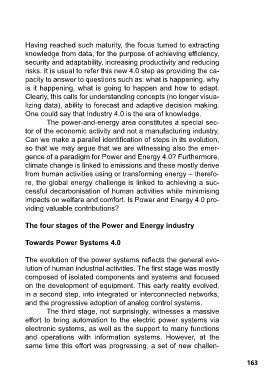Page 163 - UNAM-GCUB2022
P. 163
Having reached such maturity, the focus turned to extracting
knowledge from data, for the purpose of achieving efficiency,
security and adaptability, increasing productivity and reducing
risks. It is usual to refer this new 4.0 step as providing the ca-
pacity to answer to questions such as: what is happening, why
is it happening, what is going to happen and how to adapt.
Clearly, this calls for understanding concepts (no longer visua-
lizing data), ability to forecast and adaptive decision making.
One could say that Industry 4.0 is the era of knowledge.
The power-and-energy area constitutes a special sec-
tor of the economic activity and not a manufacturing industry.
Can we make a parallel identification of steps in its evolution,
so that we may argue that we are witnessing also the emer-
gence of a paradigm for Power and Energy 4.0? Furthermore,
climate change is linked to emissions and these mostly derive
from human activities using or transforming energy – therefo-
re, the global energy challenge is linked to achieving a suc-
cessful decarbonisation of human activities while minimising
impacts on welfare and comfort. Is Power and Energy 4.0 pro-
viding valuable contributions?
The four stages of the Power and Energy industry
Towards Power Systems 4.0
The evolution of the power systems reflects the general evo-
lution of human industrial activities. The first stage was mostly
composed of isolated components and systems and focused
on the development of equipment. This early reality evolved,
in a second step, into integrated or interconnected networks,
and the progressive adoption of analog control systems.
The third stage, not surprisingly, witnesses a massive
effort to bring automation to the electric power systems via
electronic systems, as well as the support to many functions
and operations with information systems. However, at the
same time this effort was progressing, a set of new challen-
163

